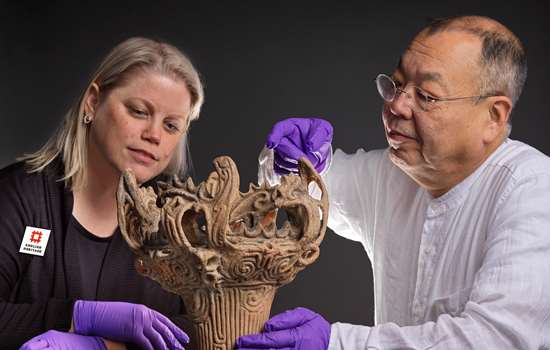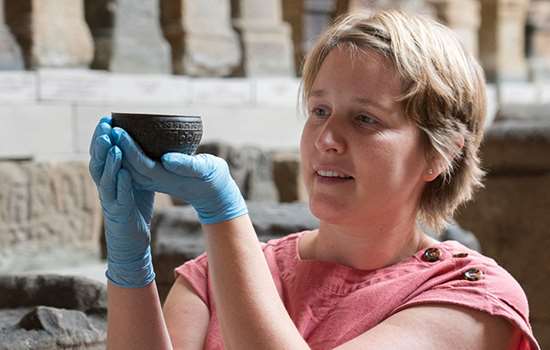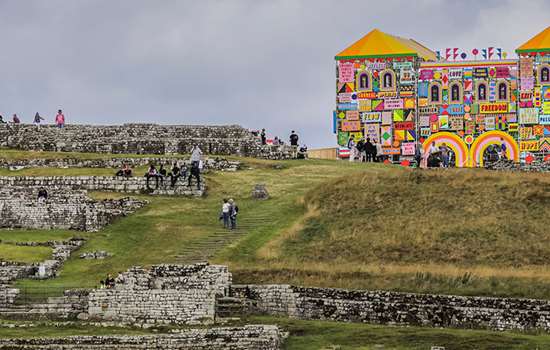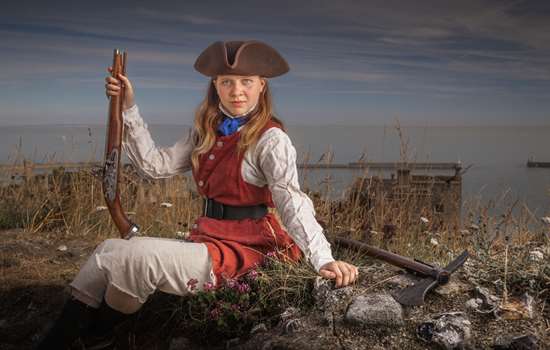03/04/2020
Working from Home: English Heritage Style
As sites remain closed to the public, English Heritage staff are taking some weird and wonderful work home with them
While English Heritage’s historic properties across the country remain closed, its curators, gardeners and conservators have gone the extra mile when it comes to working from home.
From herding sheep and planting 100 grape vines in their gardens, to studying insect traps in their living rooms, essential work continues for English Heritage staff.
Forget laptops balanced on coffee tables and crowded conference calls. Here are a few examples of how English Heritage’s experts are taking history into their own hands:
John Watkins, Head of Gardens and Landscapes, and the Ryeland Sheep
A rare (and adorable) breed of Ryeland Sheep that were destined for Boscobel House in Shropshire – the famous hiding place of King Charles II during the English Civil War – are currently cooling their heels in John Watkins’ back garden in South Herefordshire. The three one-year-old ewes were due to take up residence in Boscobel’s newly represented Victorian farm buildings. However when delays prevented their arrival, John stepped in to look after them until their new home was able to open to the public.
John Watkins said:
'The sheep weren’t too sure about their surroundings when they first arrived, but now they’ve settled down and are starting to explore the field. They are very tame and come when called, although we haven’t named them yet. It’s all very unusual – in my job I normally look after English Heritage’s historic gardens, I didn’t think I’d ever be taking sheep home with me!'
Kirsty Huggett and Emma Hallums, Collection Care Assistants, and the Pest Traps
Normally used to caring for the thousands of magnificent objects on display at Osborne – Queen Victoria’s home on the Isle of Wight – Kirsty Huggett and Emma Hallums have instead found themselves undertaking the quarterly pest trap analysis from the comfort of their homes. The pair have set to work creating their very own labs on dining room tables, examining all of the traps collected from Osborne using microscopes borrowed from the office. They have so far identified: woolly bears, webbing clothes moths, booklice and a few silverfish and woodlice. This data collection is an essential piece of work which helps English Heritage better protect its fine collection of historic wool carpets, fine tapestries, books and period clothes for future generations.
Michael Klemperer, Senior Gardens Advisor, and the Grape Vines
Lincoln Medieval Bishop's Palace – originally the administrative centre of the largest diocese in medieval England – has the only official vineyard within all English Heritage properties. As Senior Gardens Advisor in the North of England, Michael Klemperer was overseeing the project to plant, with much-needed help from volunteers, 100 new grapevines in the gardens when the site needed to close. Michael is now looking into the feasibility of the plants being delivered to him at home instead as he intends on potting them up in his own garden with the view to plant them on site at a later date.
Michael Klemperer said:
'It’s a shame we aren’t able to plant the grapevines in the vineyard as planned, but I’m hopeful I can keep them happy and healthy in my own garden. I only hope I have enough pots!'
David Thickett, Senior Conservation Scientist, and Longthorpe Tower’s Wall Paintings
English Heritage cares for 77 wall paintings, the country’s largest and most significant collection. Now almost 700 years old, the medieval wall paintings at Longthorpe Tower in Peterborough need significant care informed by science to ensure they remain intact for future generations. David Thickett has ensured he can continue his analysis at home using paint samples taken from the tower’s artwork. David is closely watching the samples to try and confirm what is causing the paint layer to form small blisters on the surface. He is recording the expansion and contraction related to humidity through weighing the samples and using a video microscope.
Dr Michael Carter, Senior Properties Historian, and the Medieval Manuscript
So determined was Michael Carter to continue his research on North Yorkshire’s Byland Abbey – probably the most ambitious Cistercian abbey built in England during the 12th century – that he acquired a late 13th-century charter at auction to study at home. The charter shows the grant of several estates to the monks of Byland by one Thomas Fossard, including lands at Sutton not far from the monastery.
Michael Carter said:
'This charter is a fascinating insight into the Abbey’s history and to be able to have a little piece of the site’s history at home when I can’t get there in person is priceless. It’s also a great read: the charter describes the Goremire, a deep lake that in the Middle Ages was thought to be bottomless. It was into the Goremire that, according to one of the Byland Abbey ghost stories, the monks threw the body of a local priest, James Tankerley, who was buried at the abbey but rose from the grave to gouge out the eyes of his mistress.'
Although English Heritage’s historic properties remain closed to the public until it is safe for them to reopen, there is still essential work which must continue to care for these important buildings, monuments and their collections.
English Heritage is a charity and is reliant on the support of its visitors, members and donors to help it look after the sites that together tell England’s story.
For more from English Heritage, follow us on Facebook, Twitter and Instagram.



